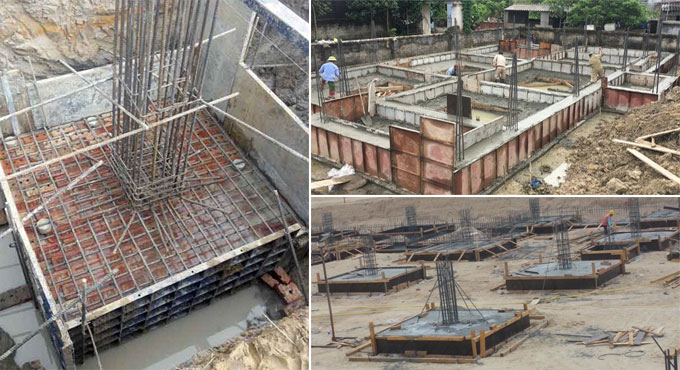
Types of Foundations in Construction Industry
Today, we shall talk about the common sorts of foundations in buildings. Generally, all foundations are divided into 2 categories: shallow and deep. The words ?shallow? and ?deep? check with the depth of soil during which the inspiration is created.
Shallow foundations may be created in depths of as very little as 3 feet, whereas deep foundations may be created at depths of sixty ? 200 feet. Shallow foundations are used for little, lightweight buildings, while deep ones are for giant, serious buildings. The following sorts of Foundations In Building Construction may be elaborated below.
Raft or Mat Foundations: Raft Foundations, conjointly referred to as Mat Foundations, are most frequently used once basements are to be made. In a raft, the complete basement floor block serves as the foundation; the burden of the building is unfold equally over the entire footprint of the building. it's referred to as a raft as a result of the building is sort of a vessel that ?floats? in an exceedingly ocean of soil.
Mat Foundations are used wherever the soil is weak, and thus building hundreds have to be compelled to meet an oversized space, or wherever columns are closely spaced, which suggests that if individual footings were used, they might hit one another.
Shallow Foundations: Shallow foundations are referred to as unfold footings or open footings. The ?open? refers to the very fact that the foundations are created by 1st excavating all the planet until all-time low of the footing, so constructing the footing. Throughout the first stages of labor, the complete footing is visible to the attention, associated is so referred to as an open foundation.
The concept is that every footing takes the focused load of the column and spreads it out over an oversized space,so that the particular weight on the soil doesn't exceed the safe bearing capability of the soil.
There are many forms of shallow footings: individual footings, strip footings and raft foundations.
In cold climates, shallow foundations should be protected against freezing. This can be as a result of water within the soil round the foundation can freeze and expand, thereby damaging the inspiration. These foundations ought to be engineered below the frost line, that is that the level within the ground higher than which freeze happens.
If they can't be engineered below the frost line, they must be protected by insulation: commonly a touch heat from the building can permeate into the soil and forestall freeze.
Individual Footings: Individual footings are one in every of the foremost straightforward and customary sorts of foundations. These are used once the load of the building is carried by columns. Usually, every column can have its own footing. The footing is simply a square or rectangular pad of concrete on that the column sits.
To get a awfully rough plan of the scale of the footing, the engineer can take the full load on the column and divide it by the safe bearing capability (SBC) of the soil. for instance, if a column includes a vertical load of 10T, and also the SBC of the soil is 10T/m2, then the area of the footing are 1m2.
In application, the styleer can explore several different factors before making ready a construction design for the footing. Individual footings are typically connected by a support beam, a horizontal beam that's engineered at ground or below ground level.
Pile Foundations: A pile is largely an extended cylinder of a powerful material like concrete that's pushed into the bottom in order that structures may be supported on prime of it. Pile foundations are utilized in the subsequent situations:
When there's a layer of weak soil at the surface. This layer cannot support the burden of the building, therefore a lot of the building has to be compelled to bypass this layer and be transferred to the layer of stronger soil or rock that's below the weak layer.
When a building has terribly serious, focused loads, such as in an exceedingly high rise structure. Pile foundations are capable of taking higher hundreds than unfold footings. There are 2 sorts of pile foundations, every one of that works in its own approach.
End Bearing Piles: In end bearing piles, the bottom-low end of the pile rests on a layer of particularly sturdy soil or rock. The load of the building is transferred through the pile onto the sturdy layer. In a sense, this pile acts sort of a column.
The key principle is that the bottom low end rests on the surface that is that the intersection of a weak and powerful layer. The load so bypasses the weak layer and is safely transferred to the sturdy layer.
Friction Piles: Friction piles work on a special principle. The pile transfers the load of the building to the soil across the total height of the pile, by friction. In different words, the complete surface of the pile, that is cylindrical in form, works to transfer the forces to the soil.
To visualise how this works, imagine you're pushing a solid metal rod of around 4mm diameter into a tub of frozen ice cream. Once you've got pushed it in, it's sturdy enough to support some load. The bigger the embedment depth within the frozen dessert, the additional load it will support. This can be somewhat almost like a friction pile works. In an exceedingly friction pile, the number of load a pile will support is directly proportional to its length.
In apply, however, every pile resists load by a mix of finish bearing and friction. Above all are basic sorts of Foundations In Building Construction. Please let us know how we are doing in the comments form.


